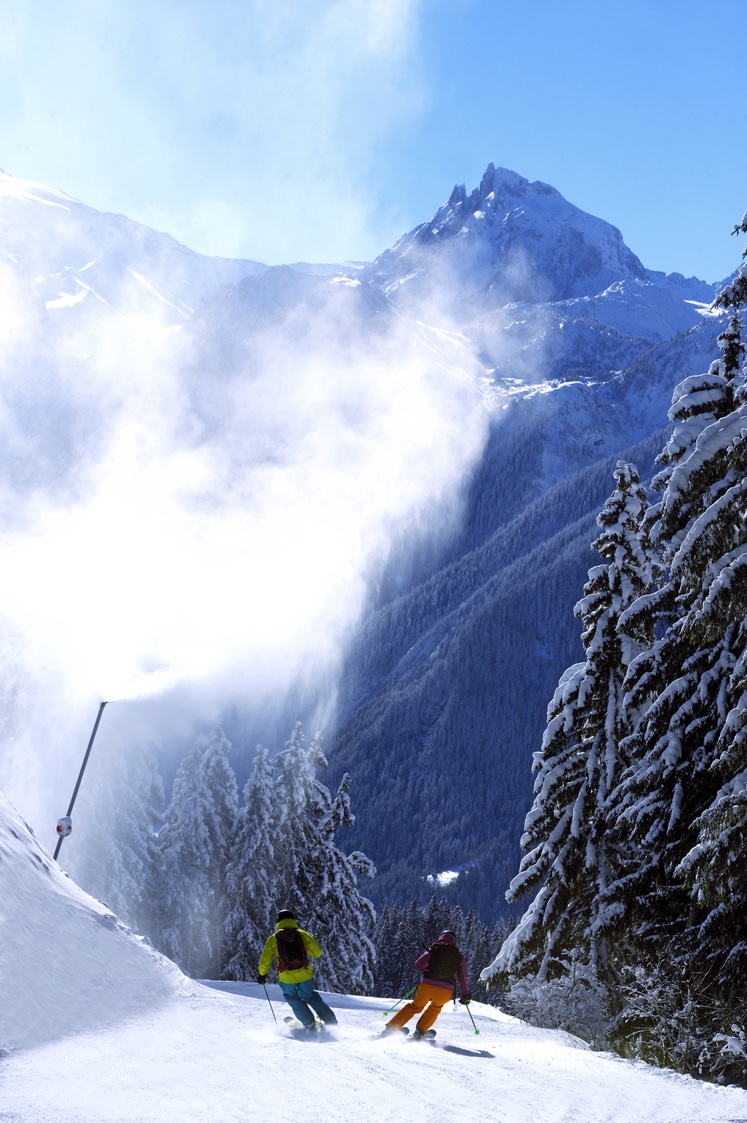The Making of Artificial Snow
Artificial snow production is a fascinating process that often sparks numerous beliefs and questions. When do we resort to artificial snow? How is it produced? What is the purpose? Is it environmentally friendly? In this article, we address all your questions.

ARTIFICIAL SNOW IN THE PARADISKI AREA IN NUMBERS…
Firstly, it's essential to know that only 30% of the domain Paradiski is equipped with snow cannons, which represents a snow-covered surface area of 323 hectares out of 1066 hectares. So you ski most of the time on natural snow! Artificial snow provides inter-resort connections, ski-to-door returns to the bottom of the area, and complements the natural snow cover.
Storage
For example, at La Plagne, five reservoirs enable artificial snow production, while at Les Arcs/Peisey-Vallandry, there are three reservoirs. This adds up to a total water capacity3 of 1,010,000m³ for the entire Paradiski area.
For comparison, this represents 0.5% of the Tignes dam and its 230,000,000m³ of water.
Production Volume
It takes approximately 650,000 m³ of water to produce artificial snow over a season. La Plagne. To Arcs/Peisey-Vallandry, the forecast water volume is 495,000 m3 of water.
For the Paradiski area, this represents the volume of about 305 Olympic swimming pools..
Production
It is considered that 1m³ of water produces 2m³ of snow..
WHAT'S THE RECIPE FOR MAKING ARTIFICIAL SNOW?
Ingredients:
To make snow, you only need three ingredients:
- water
- air
- favorable conditions
Execution:

Water
It must be pressurized, cold (between 0.5°C to 3°C), and filtered.
Air
The air must be pressurized using the same system as an 8-bar car compressor.
Favorable conditions
Two conditions are crucial in artificial snow production: temperature and the humidity level in the air.
Artificial snow can be produced from -3°C and humid conditions.
What is humid temperature? It simply takes into account the humidity level in the temperature. For example, -3°C humid represents a temperature of 2°C and a humidity level of 20%.
WHEN AND WHY DO WE PRODUCE ARTIFICIAL SNOW?
The Principle of Prudence
We generally resort to artificial snow production in the early season to prepare a solid base capable of accommodating freshly fallen snow. It ensures substantial and sufficient snow coverage throughout the season to welcome winter sports enthusiasts.
Our Snowmaking Policy: Producing the Right Amount of Snow!
Our commitment in the Paradiski area is to produce the right volume of snow—what is needed to operate our ski area, neither more nor less.For this, we know the snow production per snowmaker that allows us to open our ski area (useful production per snowmaker) and the "Maxi" production per snowmaker that ensures the entire season. Throughout the season, we refine the "Maxi" production based on natural snow conditions.
Furthermore, we work on the quality of the snow produced to make our customers very satisfied. Indeed, we can choose the quality of the snow produced for each snowmaker (on a scale from 0 to 10: 0 for dry and 10 for wet).
AN ENVIRONMENTALLY FRIENDLY PRODUCTION
The first thing to know is that absolutely no additive is added to the water used to make artificial snow.The water used for artificial snow production is checked once a month by the municipality, and the quality of this water must be equivalent to drinking water.Thus, there is no risk to the environment during melting.
In parallel, it is essential to note that the water in the reservoirs comes from snowmelt or from taking an excess of drinking water. In spring, for example, the reservoir of Adret des Tuffes in Les Arcs is filled with meltwater. During the summer, the reservoir is used as a fishing activity area. In the following winter, the water returns to the snow network to be transformed again into snow. We can talk about a closed-loop operation..